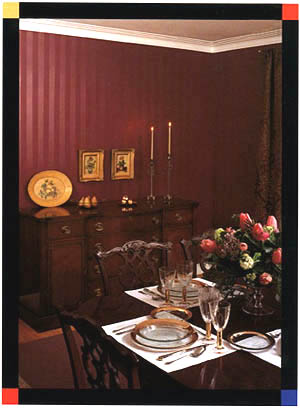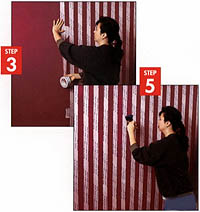|
6
Easy Steps to Shadow Striping
- Paint wall(s) in the base colour using Regal Wall Satin latex flat (#1357 was
used here).
- Using a level, make small tick marks (chalk is preferable) about three inches
form the corner, creating a straight vertical line.
- Using a two inch wide low tack painters' tape
such as Easy Mask or Kleen Edge, mask down the wall, lining up
the edge of the tape with the marks. Erase marks once tape is in
place.
- Tape entire wall or area. Adjust pieces of
tape that are not straight.
- Using Benjamin Moore's Latex Acrylic
High-Gloss Urethane and a brush or roller, paint in between the strips
of tape.
- Remove tape before Urethane is dry to prevent
its bonding to the wall.
Shadow Striping Tips
- Usually, a darker base colour creates more
contrast in the final look.
- Stripe widths do not have to be even, you can
vary the width, using a one inch and a three inch striping pattern
or even work your way up from one inch to five inches and back
again, creating a wave pattern.
- The best rule of thumb is to use standard tape
widths as your guide for stripe widths. That way there is less
measuring and, therefor, less chance of making a mistake.
- Keep in mind that the wider the stripes, the
faster the job.
- This finish really becomes apparent on long
walls, so it's great in halls.
Compliments of: Hyde Park Paint & Paper,
London
|
|



|